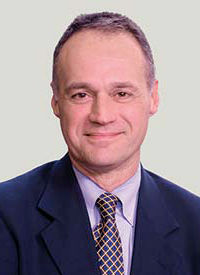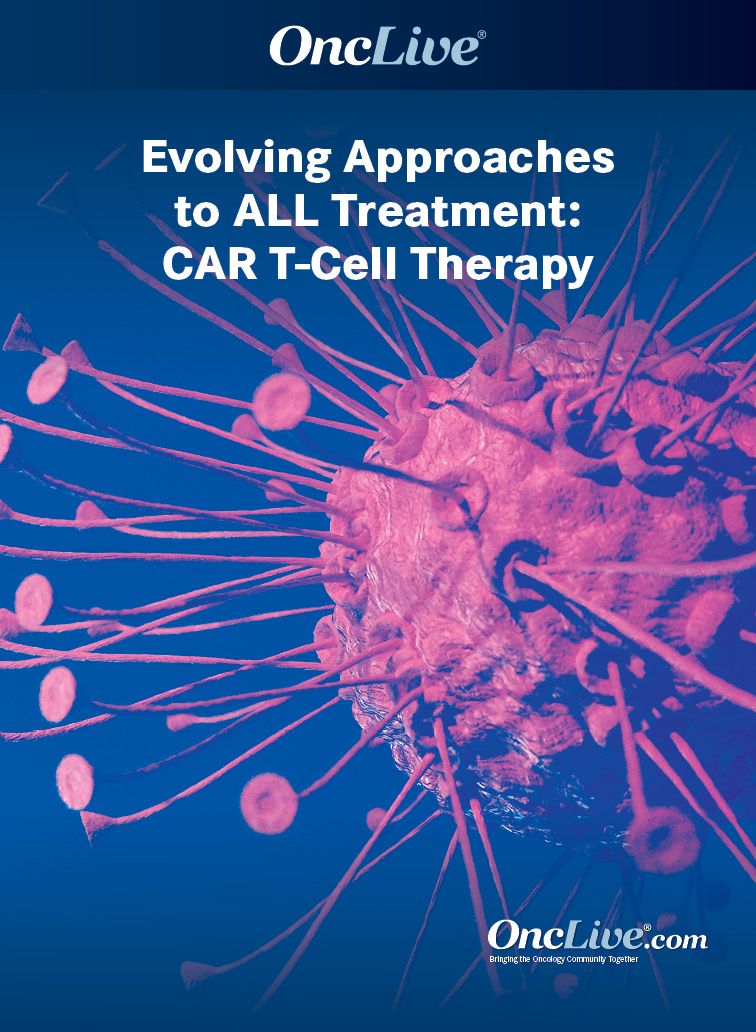FELIX Pooled Analysis Findings Potentiate Further Obe-Cel Development in B-ALL
Michael R. Bishop, MD, discusses the rationale for and key findings from the FELIX trial of obe-cel in B-cell acute lymphoblastic leukemia.
Michael R. Bishop, MD

Obecabtagene autoleucel (obe-cel; AUTO1) is safe and effective for patients with relapsed/refractory B-cell acute lymphoblastic leukemia (B-ALL), and represents the latest advancement in CAR T-cell therapy for patients with hematologic malignancies, according to Michael R. Bishop, MD.
The phase 1b/2 FELIX trial (NCT04404660) evaluated the CAR T-cell therapy obe-cel in patients with relapsed/refractory B-ALL. Topline results from cohort A of this trial, which included 94 patients with morphological disease (≥5% bone marrow blasts), showed that obe-cel led to an overall response rate of 76% (95% CI, 66%-84%; P < .0001) in this population, including a 54.3% complete response (CR) rate and a 21.3% rate of CR with incomplete count recovery (CRi).1 Furthermore, 97% of evaluable responders had minimal residual disease (MRD)–negative disease at 10–4 by flow cytometry.
Findings from a subsequent pooled analysis of all 3 cohorts in this trial, which were presented at the 2023 ASH Annual Meeting, demonstrated that among 127 treated patients, 74% of patients with morphological disease (n = 98) achieved a CR/CRi, and 95% of responders were MRD negative.2 Moreover, 100% of evaluable patients without morphological disease (n = 29) were MRD negative.
“[Obe-cel] is another option for patients with relapsed and refractory ALL, and now we’re improving upon [the efficacy of CAR T-cell] products, [which are associated with] less toxicity but equal efficacy [as earlier products],” Bishop said in an interview with OncLive®. “Now, we need to get the efficacy higher.”
In the interview, Bishop, a professor of medicine and the director of the Hematopoietic Stem Cell Transplantation Program at the University of Chicago Medicine in Illinois, discussed unmet needs in B-ALL that prompted the initiation of the FELIX trial, key efficacy and safety findings with obe-cel in B-ALL, and the future implications of this research.
OncLive: What was the rationale for conducting the FELIX trial?
Bishop: The first aspect of the rationale is there is a huge unmet need for patients with relapsed and refractory B-ALL. Once [patients progress on] immunotherapies, such as blinatumomab [Blincyto] and inotuzumab ozogamicin [Besponsa], or don’t respond to initial induction therapy, their outcomes are quite poor.
Secondly, there has been remarkable progress with the use of CAR T cells for these patients. Two CAR T-cell products are currently FDA approved [for patients with B-ALL], one for adults and one in pediatrics. Although the latter product generates remarkable response rates, it is associated with a relatively high degree of toxicity in the forms of cytokine release syndrome [CRS] and neurotoxicity. There is space within [this disease] to try to improve upon those results.
What methods did this trial use, and what patient population was evaluated?
This was a combined phase 1/2 study. [At the 2023 ASH Annual Meeting, we presented] compounded results. There were 3 cohorts. One included patients with morphologic evidence of disease, which was defined as greater than 5% blasts within the bone marrow.
The second cohort [consisted of patients] deemed to be in complete morphologic remission, defined [as having either] complete or incomplete hematologic recovery, but who were still found to have minimal measurable disease. [MRD is measured] by multiple methods, but in this study, it was [measured] by flow cytometric analysis, which is commonly used across the world.
[Patients in the] third cohort may have been in CR but had extramedullary disease [EMD]. EMD [occurs] outside the bone marrow and is generally associated with a poor outcome. [Patients with EMD are] more difficult to treat than those with disease isolated to the bone marrow and peripheral blood.
What updated findings from FELIX were presented at the 2023 ASH Annual Meeting?
This [presentation of the data] was an update to what had [previously] been presented. The first paper that [described outcomes from FELIX was published] in the Journal of Clinical Oncology [in 2023] by my colleague Claire Roddie, MD, [of University College London in the United Kingdom], as well as other investigators on this study.
[The findings from the pooled analysis] built upon [previously reported] results, provided us with further evidence of [how obe-cel performed] in the 3 patient cohorts, and [evaluated] what kind of disease burden patients had coming into cell therapy. Patients receive lymphodepleting chemotherapy immediately before CAR T-cell therapy, which has 2 purposes: to try to lower disease burden, because we think disease burden plays an important role both in the efficacy and the adverse effects [(AEs) associated with CAR T-cell therapy], and to create immune space. The [pooled analysis] broke that down and evaluated the AE profiles for those various patient groups.
What is the safety profile of obe-cel?
The toxicities are an important aspect of this study. Obe-cel has a specific receptor. Most of the CAR T cells that are used for non-Hodgkin lymphoma and ALL use the same receptor [as each other]. What makes obe-cel unique is it has its own specific receptor that, like the other CAR T-cell products, targets the protein CD19, but has a rapid on and off [mechanism], more like what we would see biologically. That rapid on-and-off [mechanism] with its target antigen is thought to decrease toxicity.
[In FELIX], we saw a relatively low rate of CRS [in] the entire population. The incidence of grade 3 [or higher] CRS was 2%. The [rate of] grade 3 [immune effector cell–associated neurotoxicity syndrome] was 7%. Those are low numbers relative to what is seen with other CAR T-cell products that target CD19, specifically in ALL.
How might obe-cel bolster the B-ALL treatment paradigm in the future?
[Obe-cel] adds to the armamentarium. The efficacy was relatively high, with a CR/CRi rate of 74%. Most patients [who achieved a CR also] achieved MRD negative status, [which has] become the gold standard for patients with ALL. You could look under the microscope and see a morphologic remission [in patients who achieve CR]. However, there are limitations to the microscope, and MRD [negative] status correlates with better outcomes. Ninety-five percent of these patients achieved MRD negativity, which is great.
However, CRS and neurotoxicity [raise concerns], particularly in adult patients. [With] low rates [of these AEs associated with obe-cel], we can feel more comfortable [using this agent], especially in patients with higher disease burden. In patients with lower disease burden, the outcomes were even better. The CR/MRD negativity rate was 95%. Even the toxicity [rates were] lower [than those seen with other CAR T-cell therapies].
What is your main message for colleagues regarding the use of obe-cel in B-ALL?
There are increasingly good [treatment] options for patients with relapsed and refractory B-ALL. Identifying those patients early, particularly the high-risk patients, [is important so they are] at least considered for this [therapy]. [Furthermore, do not] be frightened away by potential toxicity, because the high degree of efficacy that is seen with [obe-cel] is important.
What we have to do [in research] moving forward is [address] the need for allogeneic stem cell transplantation in these patients with relapsed and refractory disease, particularly in those who have not received prior allogeneic stem cell transplant. We haven’t answered that question yet, but it’s an important question to answer and therefore, we need patients [to participate] in further clinical research. Referring those patients as early as possible is important.
References
- Roddie C, Sandhu KS, Tholouli E, et al. Safety and efficacy of obecabtagene autoleucel (obe-cel, AUTO1), a fast-off rate CD19 CAR, in relapsed/refractory adult B-cell acute lymphoblastic leukemia (r/r B-ALL): top line results of the pivotal FELIX study. J Clin Oncol. 2023;41(suppl 16):7000. doi:10.1200/JCO.2023.41.16_suppl.7000
- Roddie C, Sandhu KS, Tholouli E, et al. Obecabtagene autoleucel (obe-cel, AUTO1) for relapsed/refractory adult B-cell acute lymphoblastic leukemia (R/R B-ALL): pooled analysis of the ongoing FELIX phase Ib/II study. Blood. 2023;142(suppl 1):222. doi:10.1182/blood-2023-179454




